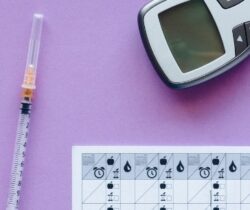Pre-diabetes is a condition where a person’s blood glucose levels (BGLs) are higher than normal but not high enough to be diagnosed as type 2 diabetes.
Pre-diabetes is widespread. According to Diabetes Australia, two million Australians have the condition and are consequently at risk of developing type 2 diabetes—approximately 5-10% of people with pre-diabetes develop type 2 diabetes each year.
However, the onset of type 2 diabetes can be prevented or delayed.
This article will tell you what you need to know about pre-diabetes and, most importantly, some steps that you can take to help reduce your risk of pre-diabetes progressing into type 2 diabetes.
Pre-diabetes
Pre-diabetes signals that your body has stopped processing blood glucose properly. When food is digested, glucose (sugar) goes into your bloodstream. The pancreas then releases a hormone called insulin which helps the glucose to move into your cells to be used up as energy; this lowers the amount of glucose in your blood. When your blood glucose level starts to drop, the pancreas slows down the secretion of insulin into the blood. With pre-diabetes, this process is not working effectively and glucose starts to build up in your bloodstream.
There are two types of pre-diabetes, impaired glucose tolerance (IGT) and impaired fasting glucose (IFG). Both involve elevated blood glucose levels.
Risk factors of pre-diabetes
The exact cause of pre-diabetes is unknown, but its risk factors are similar to those for type 2 diabetes. They can be split into two groups:
- modifiable (meaning that they can be changed)
- non-modifiable (meaning that they can’t be changed).
Modifiable risk factors include your weight, your diet and the amount of exercise you do. Non-modifiable risk factors include your age, ethnicity and your family medical history. A more detailed list of the risk factors can be found here.
Symptoms of pre-diabetes
Pre-diabetes often has no warning signs or symptoms. Most people find out they have pre-diabetes if their doctor orders a blood test, which is likely to happen if the doctor decides that you are at risk of type 2 diabetes.
See your doctor if you have any signs that your pre-diabetes has moved on to type 2 diabetes, including:
- being more thirsty
- urinating a lot
- feeling very tired
- blurred vision
Being diagnosed with pre-diabetes does not mean that you’ll automatically develop type 2 diabetes. You can prevent or delay this progression by making healthy lifestyle changes.
Prevention strategies: learn how to prevent pre-diabetes from progressing to diabetes
You can prevent or delay type 2 diabetes with lifestyle modifications. These include eating healthily, being physically active and maintaining or reaching a healthy weight. It’s also helpful to manage your stress levels and, if you smoke, quit.
Eating healthily
A healthy diet includes fresh fruits and vegetables, lean meats/alternatives (e.g. legumes) and whole grains. Consume less junk food and fewer sugary drinks. If you drink alcohol, try to reduce the amount.
Being physically active
Aim to do at least 30 minutes of ‘moderate intensity’ physical activity most days. Moderate intensity activity could be fast walking, swimming or bike riding. Alternatively, you can also choose to do three shorter bursts of activity for 10–15 minutes at a time.
Maintaining a healthy weight
Reaching and maintaining a healthy weight lowers your blood glucose levels. If you’re living in a larger body size, losing just 5% of your body weight can significantly reduce the risk of type 2 diabetes and heart disease.
Stop smoking
Smoking is a risk factor for developing type 2 diabetes so it’s very important for people with pre-diabetes to quit. If you are considering doing so, we recommend that you:
- Call Quitline on 131 848 or visit the Quitline website – https://www.quit.org.au/
- Talk to your doctor or chemist about additional options.
Manage your stress
Stress can raise your blood pressure and can also lead to unhealthy behaviour such as drinking too much alcohol or overeating. The lifestyle changes you can make to reduce stress include:
• exercising regularly
• giving yourself some time to relax each day
• socialising and having fun
• eating healthily
• having a good sleep schedule.
Monitoring blood glucose levels to help keep them in a healthy range can help prevent pre-diabetes from progressing to type 2 diabetes. Your doctor may order blood tests to monitor your blood glucose levels.
Nutrition and diet: discover the role of nutrition in managing pre-diabetes
Although there is no nutritional advice that is aimed specifically at the management of pre-diabetes, people who are living with the condition are encouraged to eat a nutritious diet that will help restore pre-diabetes glucose levels to a healthy range.
The Australian Dietary Guidelines and the Australian Guide to Healthy Eating explain what a healthy, nutritious diet is. The Guidelines make the following five recommendations:
- To achieve and maintain a healthy weight, be physically active and choose amounts of nutritious food and drinks to meet your energy needs.
- Enjoy a wide variety of nutritious foods from the five food groups every day. And drink plenty of water.
- Limit intake of foods containing saturated fat, added salt, added sugars and alcohol.
- Encourage, support and promote breastfeeding.
- Care for your food; prepare and store it safely.
The five food groups mentioned in the second guideline are:
- Fruits
- Vegetables
- Grains—includes foods made from wheat, rice, oats, cornmeal, barley or other cereal grains.
- Protein—includes lean meat, poultry, seafood, beans and peas, eggs, nuts and seeds.
- Dairy—includes low-fat milk, yoghurt, cheese and fortified soy milk.
The Australian Guide to Healthy Eating shows the proportions of the five food groups we should eat every day.
People who are living with pre-diabetes can eat a wide range of foods from these groups that are high in fibre and low in the glycaemic index (GI). The glycaemic index is a measure of how quickly the carbohydrates in a food are absorbed into the bloodstream. Foods with a high GI are quickly digested and absorbed, causing a rapid rise in blood sugar levels. Foods with a low GI are digested and absorbed more slowly, resulting in a more gradual rise in blood sugar levels.
Foods that are high in fibre can also help as they too slow down the absorption of sugar into the bloodstream. They also provide other health benefits such as helping to lower cholesterol levels and promoting feelings of fullness, which can assist in weight management.
Foods that are both low GI and high in fibre include:
- almonds
- apples
- barley
- black beans
- broccoli
- carrots
- chia seeds
- chickpeas
- kidney beans
- lentils
- oats
- oranges
- pears
- quinoa
- spinach
- sweet potatoes.
Exercise and physical activity: incorporating exercise into a pre-diabetes management plan
Exercise can be very beneficial for people with pre-diabetes. It can improve insulin sensitivity, reduce blood glucose levels and enhance joint and muscle movement. Regular exercise can help maintain a healthy weight, lower blood pressure and reduce the risk of heart disease. It also benefits mental health by reducing stress and improving sleep.
The Australian Government guidelines recommend that adults do at least 30 minutes of moderate intensity physical activity most days. Moderate intensity exercise is any activity that causes your heart to beat faster and makes you breathe harder. Examples are:
- riding a bike
- fast walking
- swimming
- gardening
- playing tennis
- water aerobics.
As an alternative, you could do three short bursts of 10–15 minutes of activity.
It’s also beneficial to do muscle-strengthening exercise (also known as resistance training) on at least two days per week. This could include:
- lifting weights
- using resistance bands
- doing vigorous gardening activities such as digging.
Don’t forget to speak to your doctor before starting any new type of physical activity. If you’re not used to doing exercise, start gently.
Pre-diabetes risks and next steps
Pre-diabetes increases your risk of developing type 2 diabetes.
If you have pre-diabetes, it is important to be aware that high blood glucose levels may have already begun to damage some of your blood vessels. Pre-diabetes has been linked with long-term harm to the heart, blood vessels and kidneys. It is also associated with what are known as ‘quiet’ or ‘silent’ heart attacks, which cause no symptoms but are still damaging.
Conclusion
Research shows that type 2 diabetes can be prevented in up to 58% of cases of pre-diabetes. It’s important to act quickly—the sooner you start, the sooner your risk level will decrease.
But it’s not easy making lifestyle changes on your own. Most of us know that we have to eat well, exercise more and lose weight, but it’s easier said than done. A great way to achieve this is to join a healthy lifestyle program and to have the support of health professionals.
This is where the Life! program can help.
Life! is a free healthy lifestyle program that helps you improve your eating habits, increase your physical activity and manage stress. You can choose from a group course or our telephone health coaching service.
The Life! program will support you to reduce the risk of your pre-diabetes progressing to type 2 diabetes.
Life! is run by experienced health professionals, including dietitians and exercise physiologists, who guide and support you to make realistic healthy lifestyle changes that suit your needs. The program includes 7 sessions delivered over a 12-month period.
Since 2007, over 75,000 Victorians have learnt more about living a healthy life with the Life! program. It is the largest prevention program of its kind in Australia.
You can take a quick online health test and check your eligibility for the program here.
Sources
Australian guide to healthy eating – Eat For Health
Diabetes – pre-diabetes – Better Health Channel
Exercise & diabetes – Diabetes Australia
Healthy diet for diabetes – Diabetes Australia
How Long Does It Take to Reverse Prediabetes? – Diabetes Strong
Mayo Clinic Q and A: How to reverse prediabetes – Mayo Clinic News Network
Pre-diabetes – Diabetes Australia
Reviewers
Kristie Cocotis, Head of Prevention and Health Promotion
Sarah Dubé, Strategy and Engagement Lead
Ria Cheripuram, Digital Communications Officer
Tegan Kohlman, Communications and Social Marketing Officer
Iftu Umar, Program facilitator and Health Coach






